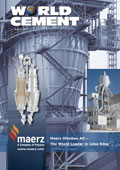Editorial comment
View the first in the new series of Katherine Markham's video commentaries below along with her comment.
Register for free »
Get started now for absolutely FREE, no credit card required.
A recent report from the WBCSD CSI (see page 11) shows that its members have achieved a 3.8% reduction in specific net CO2 emissions since 2005 and a 14.3% reduction since 1990. These figures, from cement production in 2008, reflect the great strides the cement industry has made in improving energy efficiency, increasing utilisation of alternative fuels, and the use and successful marketing of blended cements. Indeed, new types of cement seem to be making news almost daily. In the last few weeks, Lafarge has shown support for Novacem’s carbon neutral, magnesium-based cement; the Spanish company, Tecnalia, has been making headlines for its limestone-free cement; researchers from the Netherlands have seen positive results from re-paving roads with air-purifying concrete; and meanwhile road users in Minneapolis are learning that the resurfacing that is causing long delays would have been unnecessary if concrete rather than asphalt had been used for the road thanks to the PCA’s innovative billboard, which reads: ‘Hey Asphalt, Concrete Lasts 3 X Longer’. For an industry that is frequently labelled conservative, we are certainly making progress.
At around the same time these news stories were released, an article issued jointly by climate change ministers from England, France and Germany set out the economic benefits of raising the EU emissions reduction target from 20% to 30% from 1990 levels by 2020. The article is more rhetoric than substance, and the focus is on the competitive nature of low-carbon business, incentivising investment in low-carbon technology by pitting the EU against China, Japan, the US and India in a kind of ‘space race’ of the climate change era. The article acknowledges: ‘Some energy-intensive sectors will be exposed to greater costs than the average. We already try to safeguard them through free emissions allowances where necessary, and alternative measures might be needed to prevent carbon leakage over time. The real threat they face, though, is not carbon prices, but collapsing demand in the European construction and infrastructure markets. The one sure way to increase demand for the materials that these sectors produce is to put in place the incentives to boost investment in large-scale low-carbon infrastructure – voracious users of steel, cement, aluminium and chemicals.’1 Can it be, then, that low-carbon is both the question and the answer? I’m sure I won’t be alone in questioning that.
With emissions reduction in mind, this issue focuses almost completely on pyroprocessing, being the latest in our series of Special Issues. From page 34 onwards we look at burners, fuels, refractory, corrosion prevention and cooling, with case studies from plants across the world. To begin with, however, we turn our attention on the home of the 2010 FIFA World Cup (whilst neatly avoiding any mention of England’s pitiful performance), South Africa, with an article from Industry Insight that begins on page 16. This is followed by case studies from Lafarge South Africa and ASEC Cement’s Takamol plant in Sudan. For subscribers whose interests lie further north in Central Asia, Paul Maxwell-Cook takes Kazakhstan as the subject of this month’s Regional Insight, available to download from 1 August. More information about this can be found on page 9. Finally, World Cement is now on Twitter (twitter.com/World_Cement), so follow us for regular updates of up to 140 characters (= this much)!
1. Joint EU Climate Change article by Chris Huhne, Dr Norbert Röttgen and Jean-Louis Borloo, available on the DECC website at www.decc.gov.uk


